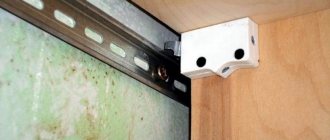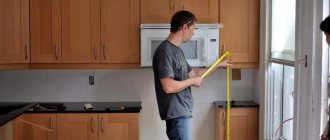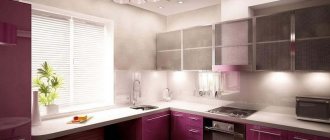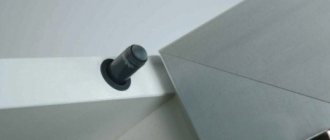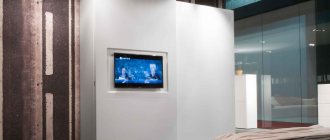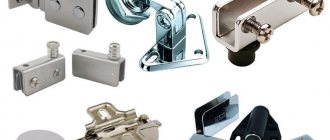How to hang kitchen cabinets on the wall is a question that worries those who do the renovation themselves. In fact, installing kitchen furniture is a simple task that even an inexperienced craftsman can handle if he has the necessary tools.
However, this applies only to the simplest fasteners (corners, furniture hinges). Currently, many other types of furniture fittings have appeared, which we will consider in more detail.
It should be remembered that improper installation can lead to wall cabinets falling, and this, in turn, poses a danger to the health of household members and the safety of the repair. Therefore, we recommend that you act without haste and follow the instructions so that everything works out.
How to Hang Kitchen Cabinets on the Wall
Gas lift and adjustable awnings for kitchen cabinets - installation of furniture according to all the rules
Adjustable canopy - appearance, colors
Design of adjustable hangers ↑
Internal structure of an adjustable eyeAdjustable canopy and rail for mounting on a wallApproximate diagram of fixing the suspension to a metal rail
How to attach the gimbal yourself: brief instructions ↑
- Adjustable canopies are recessed 5 mm relative to the rear wall. Therefore, before you begin installing the lugs to the cabinet, you should make small holes in the fiberboard to match the size of the “ear” of the suspension.
- Attach adjustable hangers to the sides of wall kitchen cabinets.
- Cut the mounting strip exactly to the size of the wall. When purchasing ready-made furniture, the tire is supplied in a specific size for each drawer.
- Attach the guide to the wall, having previously measured the required distance from the tabletop. Approximate calculation: the height of the work apron plus the height of the wall cabinet minus the thickness of the roof (usually 16 mm).
- Hang the furniture on the rail and begin adjusting the hangers.
Detailed video instructions ↑
Installing an adjustable hanger on a kitchen cabinet: How to attach a hanger to a strip: Adjusting a kitchen hanger: Universal gas lifts and adjustable hangers for kitchen cabinets make furniture installation easy.
Moreover, thanks to properly selected lifts, the usable area of the internal space of the cabinets increases and the ease of use of the kitchen set is optimized to the maximum. And technically competently installed adjustable lugs guarantee the durability of the use of upper wall cabinets. Those readers who have taken on the interesting but difficult task of independently designing their own kitchen ask, among other questions: what are the...
How to determine the standard sizes of kitchen cabinets and the overall dimensions of a kitchen set
For decades now, linoleum for the kitchen has remained the most popular type of flooring. Despite all its accessibility, this one is unique.
We choose linoleum for the kitchen according to all the rules
A clearly developed kitchen drawing is a guarantee of quick and trouble-free furniture assembly. A detailed design of a kitchen set with dimensions will help you avoid.
Useful tips
Installation of awnings is a fairly simple operation, but it requires some experience to perform it quickly and efficiently. In this case, you also need to follow a few simple recommendations:
Only high-quality hangers and certain experience will allow you to achieve the desired and correct location of all kitchen modules. In the absence of such indicators, it is advisable to entrust the solution of such problems to specialists.
Furniture hangers
The simplest thing is a self-tapping screw wrapped in a plastic dowel .
The option is not the best, because... The screws are quite thin, that is, they can bend, and some types of hangers can simply slide off the head. Although for small loads this mounting option is used very widely. The crutch is also screwed into a plastic dowel but has an L-shape. This prevents slipping even when bending the crutch. The standard sizes are presented in the plate. The option is better than a self-tapping screw, but worse than a plank (see below) if you hang several boxes in one line.
The fastening strip is a galvanized profile with holes, the upper edge of which lags behind the wall in the shape of a hook, on which the box is hung. They are only suitable for one type of hanging (below), but are very convenient if you need to hang several cabinets in one line. They are screwed to the wall with several self-tapping screws.
Let's move on to the pendants, starting with simple ones. They are a metal plate 1.5-2 mm thick with holes for fastening screws and a dowel or crutch in the wall.
Simple suspension with top fastening
Simple suspension with middle fastening
Non-adjustable corner hanger.
P-shaped suspension (right and left)
Adjustable hangers
The last word in the technique of hanging furniture on the wall. They consist of two main components: a fixing hook (clings to a crutch or bar) and an adjustment block, which is attached to the side wall of the box. Due to the presence of adjusting screws, you can move the hook in two planes: back and forth and up and down. This allows you to correct distortions in the box, as well as pull it close to the wall. They come in different shapes, including those with removable decorative overlays.
They are attached both to hooks and to fastening strips. I wouldn’t recommend using self-tapping screws for them... you know, there were precedents. Schematic diagram of fastening kitchen cabinets to such hangers using a fastening strip:
A cutout is made in the back wall for such canopies. Here are two mounting options: flush and overhead, and the recessed option is perfect when the box needs to be pulled tightly to the wall (you need to use crutches).
Selection of fittings for fastening and preparation of walls
Types of fasteners
When choosing fasteners, you need to consider several factors:
- The total mass that will be exerted on the box;
- Budget allowed for the purchase of fasteners;
- Requirements for fastening (possibility of adjustment along several axes, maximum permissible weight).
Furniture hinge
The most common and simplest fastening technology. Before installing wall cabinets in the kitchen, the walls are marked. Hinges are attached to the furniture, which are later mounted on a self-tapping screw.
Pros of the loop:
- Price. Hinges are cheap and can be found at any furniture hardware and tool store. One drawer can be equipped with several hinges for strengthening.
- Diversity. There are two types of loops: single-axis and adjustable. The first ones involve monolithic fastening, without the possibility of additional regulation. The latter can move along a horizontal axis, so it is possible to further customize the location of the furniture.
- Stealth. They are installed at the back so they are not visible.
- Easy to attach. All that is required for installation is to screw the hinges on the back. No additional cutting of grooves is required.
Minuses:
- Low load capacity. Due to their primitive structure and price, they can put pressure on the chipboard, which will lead to the box falling.
- Corrosion. Cheap hinges are made of galvanized steel. During installation, it is possible to damage the zinc layer, which will subsequently lead to corrosion.
- Minimal adjustment. Such settings cannot be further configured after installation.
- Installation duration. Each hinge requires a separate hole.
- Need for high precision. It is necessary to carry out jewelry work when drilling, since small indentations will lead to mismatched holes.
Plank
A simplified solution for installing top drawers.
Pros:
- Possibility of adjustment. Special roller mounts are installed on the bar; it is possible to adjust the furniture at your discretion along the horizontal axis.
- Aesthetics. The design is in a simple white style.
- Strength. The mount can withstand enormous loads, including from heavy ceramics and glass.
Minuses:
- Difficult to install. It is difficult to install the fasteners yourself, as you need a special tool, such as a jigsaw or milling cutter.
Ikea
This type of fastening is the most complex and this is its only drawback. Otherwise, it is a convenient mechanism that makes adjustments easy. Installation is performed according to the following algorithm:
- A stainless steel corner with a large hole is installed inside. It must have a ridge notch.
- An anchor is installed at the marked point on the wall.
- The cabinet is installed on an anchor and fixed from the inside.
Preparing the walls
This stage cannot be called mandatory. First of all, the furniture will be able to remove all the unevenness on its own. However, in some cases, when the walls are too crooked, the cabinets will not be able to be hung because they will not be able to relate to each other correctly. In this case, they will need to be pre-processed and leveled. And the fastening forms, like a mounting strip, will not be able to press tightly against the wall.
First of all, it is important to pay attention to whether it makes sense to prepare the walls when they are bare. Since furnishing is done at the final stage of arranging the room
Action plan:
- The walls need to be cleaned of previous layers of plaster and putty. We need to achieve bare concrete. Before further work, it must be dust-free.
- With a drying break, apply two coats of primer. It is better to use purchased compounds for this coating. You can make it yourself by mixing water and wallpaper glue or PVA in a ratio of 1 to 2.
- We need to install beacons. Regular aluminum profiles are best suited. They are installed vertically and to achieve a right angle, you need to use a weight or a plumb line.
- A primary plaster solution is applied to the walls. To do this, prepare a large amount of the composition and quickly throw it in with a spatula. After this, you need to quickly align them with an even bar according to the thickness of the beacon.
- After it hardens, it is coated with finishing putty for concrete.
Kitchen cabinet hangers are the easiest way to securely hang kitchen furniture
Anyone who has encountered this type of work such as installing hanging cabinets in the kitchen knows how difficult this process is. It is necessary not only to ensure reliable fastening, but also to align several parts of the structure perfectly level, which can be difficult with conventional eyes. But if you use special awnings, you can easily cope with the work yourself and achieve an ideal result, even if you are installing it for the first time.
To keep the cabinets firmly and level, it is necessary to use special awnings
Advantages of this system for fastening furniture in the kitchen
- Wide range of adjustments . The height of the structure can be varied up to 15 mm in order to perfectly match all parts of the kitchen set. As for the distance from the wall, it can be up to 25 mm; even if you have a protruding tile apron in the kitchen, you can place the cabinets flush with the surface without losing reliability;
- Possibility of installing kitchen cabinets alone . Since the work consists of several stages, you can do everything yourself, because you don’t need to hold the structure to get onto the hooks or screws. The hooks on the modules very easily and reliably cling to the metal strip on the wall; there is no need to align anything, and this greatly simplifies the work;
- High reliability of the design . The cabinets hold up much better on such a system, even if one or more fasteners of the metal strip become loose or become loose, the rest will not allow the structure to fall, which is very important. It turns out that the furniture is not held on by two screws, as is the case with eyelets, but by 3-4 or even ten; if you wish, you can screw a lot of fasteners into the wall;
- Short terms of work . Even if you are installing it for the first time, it will take you no more than a few hours for the entire kitchen. Moreover, all the work is quite simple, the main thing is to perform them in the correct sequence and be careful;
- Possibility of mounting with a distance from the wall . A very important plus for those whose kitchen apron protrudes beyond the surface of the wall. Now the cabinets will not hang askew, you can adjust their position in a matter of minutes;
- Strength of elements . The permissible load on one canopy is 30 kg, that is, the locker can weigh up to 60 kg, which is unlikely to happen, since it is impossible to stack so many heavy things in a small space.
By plane
The adjusting screw is responsible for changing the position of the facade along the plane; by turning it, you can move the sashes to the right or left. This eliminates distortions of the door relative to the body and the adjacent door.
To eliminate distortions to the right or left, you need to tighten or loosen the adjusting screw. Carry out opposite manipulations with hinges located at different heights until the door is perfectly aligned.
To eliminate distortions to the right or left, you need to tighten or loosen the adjusting screw
Adjustable hidden cabinet hanging
Agree that the modern mount looks much nicer and neater
Advantage of fastening
- Possibility to install cabinets without assistants. All work is carried out in two stages: installing a metal strip on the wall and hanging the module on it. You don't have to feel around for screws in the wall to get the loop onto the head.
- Possibility to adjust any position of the cabinet, an error of 15 mm is allowed on each side. In this case, you do not need to support or remove the module; the entire adjustment process is carried out overhead.
- The hanging cabinet for the kitchen becomes more reliable. The fastening allows you to fix a single fastening strip on the wall, so that even if 2-3 screws become loose, the rest will hold the structure.
- A hanging kitchen cabinet can be installed directly on the wall on a kitchen apron. This is possible due to the retractable mounting bracket, which allows you to hang the module at a distance of 2-2.5 cm from the wall.
How many hinges do you need to buy to securely install the door?
To install hinges on doors yourself, first of all, you need to determine the required number of devices. It depends on the dimensions and weight of the door being hung, as well as the material from which it is made.
How many pieces do you need to buy depending on the weight and height of the facade?
In order for the hinges to fully cope with their assigned task - to ensure the free opening/closing of doors without creaking or moving, they must be installed correctly. Usually, instructions are always attached to the product.
The video will also help you understand the installation principle:
Hanging for kitchen cabinets
- What is
- These pendants were of several types
- Advantages
- Mounting instructions
- Next, install the canopy on the box
- Now you can hang the cabinet itself
- Installing hangers on the cabinet
These pendants were of several types
A simple suspension with a fastening in the middle is the same simple suspension; the hole for the screw on it was located between two others, with the help of which it was attached to the cabinet. Unlike the previous one, it is not visible, but visiting such a suspension on a screw in the wall is very problematic.
The suspension is angular, non-adjustable. It is mounted on the top wall of the cabinet. At the same time, using the oval mounting hole, it is possible to adjust the distance of the drawers to the wall. But a significant drawback is its visibility not only from above the cabinet, but also when opening the doors inside.
P-shaped suspension (right and left). It is attached simultaneously to the side and top walls of the cabinet, thereby performing the additional function of a screed. Its large hole does not require precise marking for a screw on the wall, but its disadvantages are the same as those of a simple hanger. Modern mounts for wall cabinets are a plastic or metal box with several holes.
Two through holes secure the canopy structure itself to the cabinet box. Two adjustment holes with large bolts, with the help of which the horizontal position of the cabinet is adjusted, as well as its position relative to the wall.
The kitchen cabinet hanger has a special mount that is installed on a mounting rail. Mounting to such a strip makes the process of hanging kitchen cabinets much easier.
Horizontal clearance
By tightening the two screws located on the ears of the strike plate, you can move the doors up and down. This eliminates sagging or upward displacement of the doors relative to the body.
By tightening the two screws located on the ears of the strike plate, you can move the doors up and down
- loosen the screws on all hinges;
- raise or lower the canvas (as appropriate);
- tighten the screws almost to the limit.
The best option is to select self-tapping screws with fine threads; they are tightly fixed in the door leaf and help to most accurately adjust the height of the facade.
How to Hang Kitchen Cabinets on a Mounting Rail
It is worth saying that attaching kitchen cabinets to the wall is a fairly important part in installing the headset. The fact is that they are at eye level, which means that all mistakes and errors will be quite significant. You must also understand that the load on the cabinets is quite large. They store dishes, appliances, and other cooking tools. In a word, it is necessary to observe all the nuances. Let's look at how to hang kitchen cabinets on a mounting rail.
Installation Features
The first rule is accurate measurements. You should not engage in installation when nothing has been highlighted and no clarifications have been made. Thus, you first need to choose fastenings, prepare the walls and only then hang them.
Professionals highlight several basic rules:
- Any hanging elements in the kitchen do not interfere with the operation of the hood.
- The set itself does not spoil the overall geometry of the kitchen, as well as its appearance.
- The height should be selected optimally for all users. If this is not done on time, some family members will experience discomfort.
- The fasteners used are reliable and durable. The safety and environment in the room depend on them.
Choosing fastenings
Before choosing them, you need to decide what the wall itself is made of. There are some tips on this matter:
- If a wooden wall is used, then hardened screws with a countersunk head will be needed.
- Brick or concrete walls require dowels, as well as anchor bolts or strong screws.
- There are also plasterboard walls. You need to be careful and choose screws and anchor bolts that can support even the heaviest hanging elements. It is worth saying that all fasteners are installed not on the drywall itself, but on a special profile.
Preparing the walls
The quality of installation largely depends on the walls. Let's look at the main rules:
- if there are bumps and depressions on the surface, it is necessary to eliminate them;
- when corner cabinets are used, the wall angle should be 90 degrees;
- do not forget to carry out electrical installation work before installing furniture;
- You need to cover the surface with wallpaper or paint before installing the headset.
Hanging on a mounting rail
A special feature of this method is the fact that a gap is formed between the furniture and the wall. To make it uniform, you should either install an additional bar at the bottom, or choose the optimal height.
Statistics show that hangers with slats have some advantages:
- All marking is much simpler.
- It is possible to carry out self-installation.
- The overall structure is considered reinforced.
- Cabinets are installed much more accurately.
- Special adjustments are already available that allow for precise adjustment.
- Installation and dismantling is much faster and easier.
- It becomes possible to arrange all the furniture in one dense row, avoiding gaps between them.
The procedure goes as follows:
- hangers are immediately hung on the side walls;
- the hook must protrude beyond the side sheet enough to catch the bar;
- measure the distance from the top hook to the top sheet of the cabinet;
- all possible places for fastenings are marked;
- Dowels are installed, and the rail is screwed to the wall.
Does the wall have a high load-bearing capacity? Then the mounting suspension is divided into several parts. There is a minus - the horizontal position of kitchen cabinets will be significantly limited.
If pipes interfere, then the rail itself is installed in such a way that this problem can be circumvented. Not only the length is selected, but also its width.
Tools and materials
In order for everything to go as efficiently as possible, you need to stock up on the following tools:
- hammer drill or impact drill;
- pliers;
- hammer;
- For even marking you will need a chop cord;
- yardstick;
- a construction level that will help determine the evenness of not only the walls, but also the installed slats.
As for materials, the following are used:
- All the necessary elements of wall kitchen cabinets.
- Screws, dowels, bolts.
- Self-tapping screws and nails.
- Metal hinges.
In general, the installation procedure is quite simple for a professional or amateur. At least there's nothing complicated about it. If you do not have enough knowledge or equipment, you should contact specialists. This way you can be completely confident in the quality of the installation.
The surface is of particular importance. They advise you to work on it right away, and then deal with installing the kitchen cabinets later. Accurate measurements will help you make the installation as smooth as possible. Not only a ruler and tape measure are used, but also a special building level.
What is important to consider when setting up loops
There are 4 conditional laws for adjusting loops, which are important to consider during operation:
- Before work, check the evenness of the cabinet on the plane; it must be leveled.
- First of all, align the door vertically.
- In some cases, optimal results may not be achieved when adjusting the height. The reason is that the door width is too wide. Therefore, tighten the screw that adjusts the width of the gap. It should be no more than 5 mm.
- When working with modular furniture stacked on top of each other, work begins with the upper cabinets. In this case, the weight is distributed correctly, and the adjustment will be most accurate.
If an anaerobic fixative is not available, enamel or paint can be applied.
To prevent the screws from quickly unscrewing, anaerobic thread lockers are applied under their heads.
Adjusting wall kitchen cabinets on a rail
How to hang kitchen cabinets on a mounting rail?
Attaching kitchen cabinets to the wall is a critical part of installing cabinetry. Since these furniture elements are located at eye level, it is important to provide for all the nuances so that no mistake or mistake in calculations will result in an unflattering appearance. In addition, the load on the cabinets is very serious: they store various kitchen utensils, dishes, cans of preserves, etc. Thus, the structure must withstand the full weight of the items. And of course, we shouldn’t forget about the general perception of the kitchen and its interior, where the furniture around us plays a special role. Based on all this, we will figure out how to hang kitchen cabinets on polyurethane foam.
Inventory I will use
So, I purchased a storage closet with two large doors. Of course, I started assembling it myself, since I had no desire to give the furniture into the wrong hands. But when it came to the hinges, I began to realize that I had placed them unevenly. Following this, I began to correct the situation. What was useful to me:
- crosshead screwdriver;
- a wooden stationery ruler (since there was no tape measure at hand);
- building level, which has a bubble mechanism.
Since my furniture was located in a fairly dark room, I thought that I could not do without additional lighting, so I brought a portable lamp from the barn. Just in case, I took a caliper.
Source palitra21.ru
How to hang kitchen cabinets?
When replacing a kitchen unit, it becomes necessary to install new wall cabinets. Since they often store a lot of dishes, cabinet fasteners must withstand heavy loads and ensure reliability. In addition, the cabinets are at eye level, and errors in calculations during installation will be obvious. There are two options for how to hang kitchen cabinets: with traditional hinges or with a mounting rail. And if the walls are lined with plasterboard, additional plasterboard anchors will be required. If the kitchen set is corner, marking and hanging cabinets start from the corner.
Hanging a cabinet with hinges
With any mounting method, first determine the height at which the cabinets will hang. It depends on the required space between them and the countertop (usually 55-60 cm) and the vertical dimensions of the cabinets. The height of the hanger will affect the ease of use of the cabinet shelves and appliances on the countertop.
A horizontal line is marked along the future upper border of the cabinet, checking it using a building level. Then determine where on the back wall of the cabinet the hinge will be screwed. It may have an indentation from the side wall. Taking this into account, a mark is made for the hook on the wall so that in the future the cabinet will have the desired horizontal position and not be shifted to the side. The mark for the second hook is usually made by placing the cabinet against the wall or by accurately measuring the distance between the hinges. The marks are checked by level.
Next, drill holes for the dowels. The minimum size of dowels for cabinets is “six”, but their actual diameter is 5.5 mm. This should be taken into account when selecting a drill so that the dowel sits tightly in the resulting hole and does not rotate. After screwing in the screws (special screws with hooks are often used), you can hang the cabinet and check its position.
To securely fasten cabinets to drywall walls, it is better to use “Molly” type anchors, which are fixed into the wall itself and, when pulled together, form a stop that distributes the load on the drywall sheet. If you hang cabinets directly on drywall, its sheet and profile may not support the weight.
Varieties
Furniture canopies are available in numerous types on the market. They differ in different parameters, so you should evaluate all the features of each option in order to choose the optimal design.
| Classification of canopies | Main varieties |
| According to the material of manufacture | Steel ones are traditional, but aluminum products are considered more in demand. An alloy of aluminum and brass is often used to create canopies. Stainless steel products are also often used, which are strong and durable. |
| By coverage | It can be anti-corrosion or decorative. Alloys typically used include copper or zinc, steel or aluminum. They can have different colors, which allows you to choose awnings that perfectly match the shade of the furniture. |
| By design | Four-joint, which are reliable and quite popular. They consist of 4 hinges and a spring element. Single-hinged models are considered outdated models that cannot cope with significant loads. |
Additionally, such products differ from each other in cost. It depends on the manufacturer and the elements included in the kit. There are many different types of canopies based on the installation method, so before purchasing a specific model, you should first study the installation instructions.
Advantages
A modern suspension has many advantages over a conventional hinge.
The only disadvantage of this mount is the price. But its advantages do not allow you to regret the cost.
